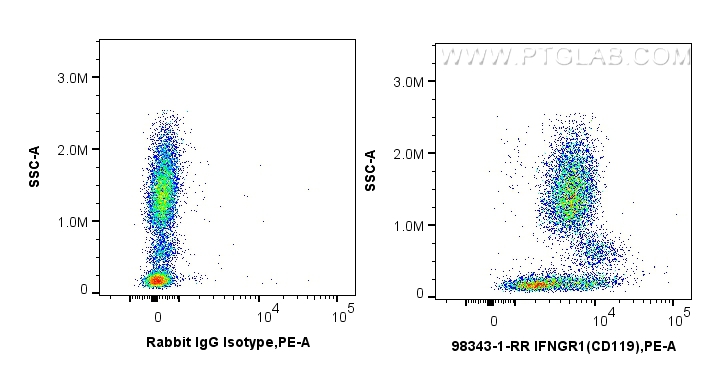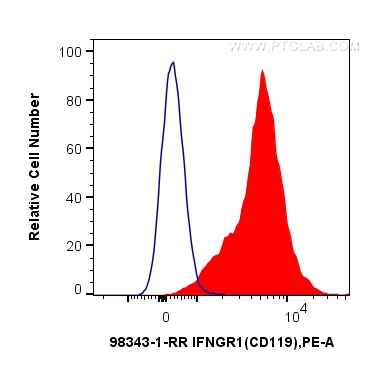验证数据展示
经过测试的应用
| Positive FC detected in | human peripheral blood leukocytes |
推荐稀释比
| 应用 | 推荐稀释比 |
|---|---|
| Flow Cytometry (FC) | FC : 0.25 ug per 10^6 cells in 100 μl suspension |
| This reagent has been tested for flow cytometric analysis. It is recommended that this reagent should be titrated in each testing system to obtain optimal results. | |
| Sample-dependent, Check data in validation data gallery. | |
产品信息
98343-1-RR targets IFNGR1/CD119 in FC applications and shows reactivity with human samples.
| 经测试应用 | FC Application Description |
| 经测试反应性 | human |
| 免疫原 |
Recombinant protein 种属同源性预测 |
| 宿主/亚型 | Rabbit / IgG |
| 抗体类别 | Recombinant |
| 产品类型 | Antibody |
| 全称 | interferon gamma receptor 1 |
| 别名 | IFNGR1, IFN-gamma receptor 1, IFN-gamma R1, IFN gamma receptor 1, IFN gamma R1 |
| 计算分子量 | 54 kDa |
| GenBank蛋白编号 | NM_000416.3 |
| 基因名称 | IFNGR1 |
| Gene ID (NCBI) | 3459 |
| 偶联类型 | Unconjugated |
| 形式 | Liquid |
| 纯化方式 | Protein A purification |
| UNIPROT ID | P15260-1 |
| 储存缓冲液 | PBS with 0.09% sodium azide, pH 7.3. |
| 储存条件 | Store at 2 - 8°C. Stable for one year after shipment. |
背景介绍
Interferon-gamam (IFN-γ) is a cytokine critical for innate and adaptive immunity against viral and intracellular bacterial infections and for tumor control. Cellular responses to IFN-γ are activated through its interaction with a heterodimeric receptor consisting of two subunits, IFNGR1 (CD119) and IFNGR2. IFNGR1 is the ligand-binding subunit which binds IFN-γ with high affinity, whereas IFNGR2 serves as the accessory subunit. Two subunits bind one IFN-γ dimer. Defects in IFNGR1 are a cause of mendelian susceptibility to mycobacterial disease (MSMD), also known as familial disseminated atypical mycobacterial infection. (PMID: 17981204; 946248; 10888113)
实验方案
| Product Specific Protocols | |
|---|---|
| FC protocol for IFNGR1/CD119 antibody 98343-1-RR | Download protocol |
| Standard Protocols | |
|---|---|
| Click here to view our Standard Protocols |



